|
With the end of the Second World War, Fort Slocum’s future was uncertain. The post was one of hundreds across the nation. Many had been built only recently as part of the war effort; however, others like Fort Slocum had long served the Army.
Fort Slocum was limited by its size and geography, but it was a well-built post that the Army had occupied for nearly a century. Two decades would pass before the Army decided finally that it no longer needed the post.
Flyboys: The Air Force on Davids Island
As the Army considered Fort Slocum’s future in 1946, city and county officials lobbied for the Army to stay, while at the same time proposing new uses should it go. New Rochelle’s mayor, Stanley W. Church, suggested Fort Slocum could easily be converted to much-needed veterans’ housing or become a campus for a public college.
The Army, however, decided that Fort Slocum would remain active, and it turned the post over to its air corps, the soon-to-be-independent U.S. Air Force. Fort Slocum became headquarters for the First Air Force, a regional defense command. This unit had been based at Mitchel Field on Long Island, but was displaced by another command.
Lacking an airfield or space to land anything larger than a light plane or a helicopter, Fort Slocum was a flightless air base. Officially, the Air Force contended that the absence of an airfield was unimportant because Fort Slocum’s job was only administrative. Nonetheless, newspaper accounts reported that some Air Force officers privately confided that the lack of flight facilities was inconvenient and the need to take a boat to work was mildly absurd.
Renaming the post Slocum Air Force Base in June 1949 did nothing to alter the fundamental drawbacks of the post. Just a few months after the name change, in October 1949, the First Air Force departed Davids Island, returning its headquarters to the more congenial facilities of Mitchel Field.
Flyboys, Soldier-Students and Missileers (1946-1965)
ACK radar CBS tower in backgroundOne of three radar antennas used by the Integrated Fire Control Area of Nike Missile Battery NY-15 at Fort Slocum, late 1950s.  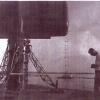 AFIS television broadcastArmy Information School student at Fort Slocum on camera for a television broadcast, circa 1960.   Armed Forces Day Nike after Nike leftNike Ajax missile on display on the Parade Ground at Fort Slocum for Armed Forces Day, early 1960s. 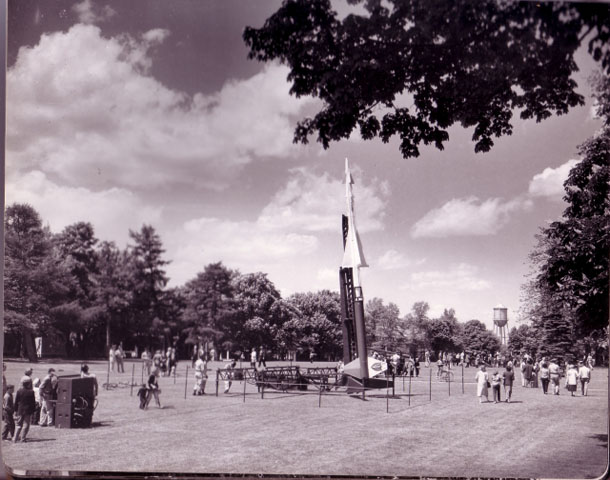  Bldg 51 Prot ChapelProtestant religious service in the Army Chaplain School's Chaplain Center for All Faiths (Building 55, originally a barracks), 1954. 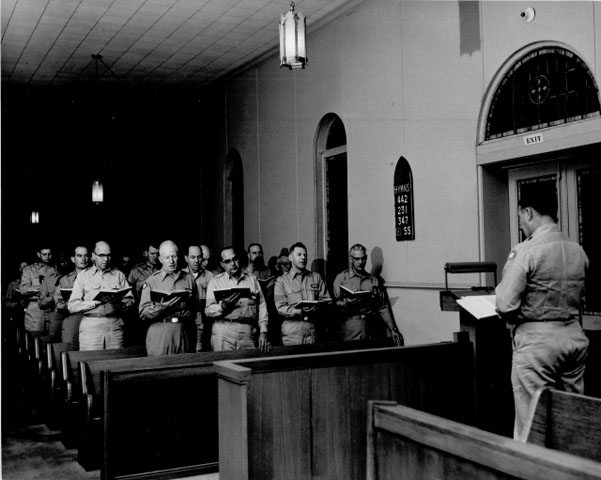  Formation Chap Sch 1956 Col Donahue C-O mThe staff and students of the Army Chaplain School at Fort Slocum, under the command of Chaplain Col. Edward Donahue, in front of the former Post Hospital, then in use as the school headquarters, 1956. 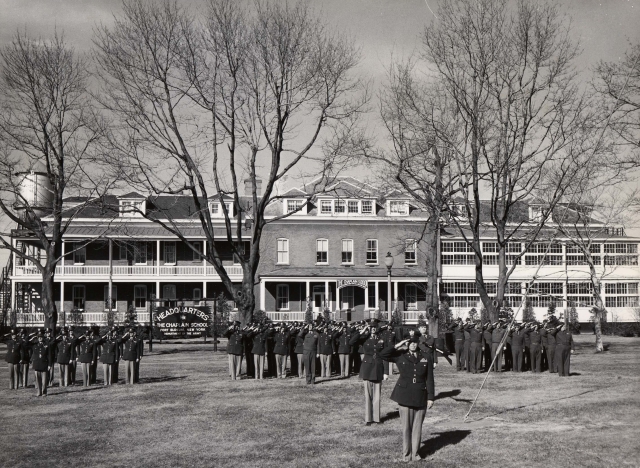  Visual Aids section-1958 AIS SC544951Army Information School students learned graphics arts to make effective visual aids, 1958. 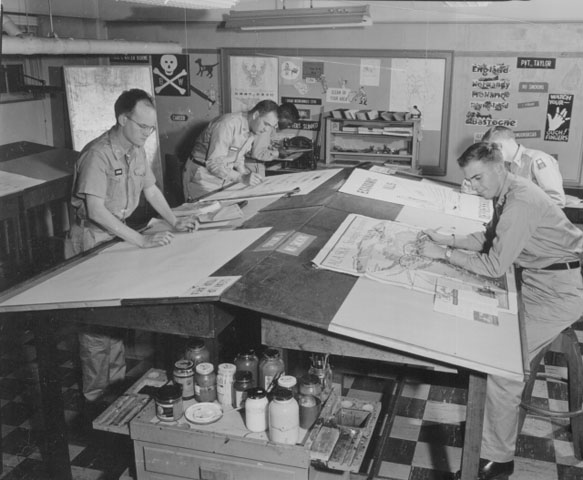 
Soldier-Students: Chaplains and Public Affairs Personnel
A short hiatus followed the Air Force’s departure, as the post entered caretaker status. Once again, local officials angled for the transfer of Davids Island to the control of New Rochelle or Westchester County if the all branches of the armed forces were done with Fort Slocum. Officials again suggested that the post could serve as a college campus and floated a proposal to convert the island to a U.S. Public Health Service hospital, but nothing came of these suggestions.
The outbreak of the Korean War in 1950 brought Fort Slocum back to active service. The Army announced plans to relocate two advanced training schools from Carlisle Barracks, Pennsylvania, to Fort Slocum. These were the Army Chaplain School and the Armed Forces Information School. Both remained at the post for more than a decade, and together they comprised Fort Slocum’s last military assignment.
The Chaplain School prepared ordained clergy from many faiths for service in the military. Its students included Roman Catholic priests, Protestant ministers, and Jewish rabbis. They already knew theology, liturgy and pastoral work. The school gave them the background knowledge and practical skills they needed to serve Army personnel on the battlefield and at peacetime posts. Training was necessarily ecumenical in spirit, for chaplains served soldiers of many faiths.
The Army Chaplain School occupied the northern end of Fort Slocum, taking the former post Hospital (Building 46) as its headquarters and main classroom building, while using the neighboring barracks, Building 55, as the site of four chapels. The school remained at Fort Slocum through 1962, when it moved to Fort Hamilton in nearby Brooklyn.
The Armed Forces Information School was established at Carlisle Barracks in 1947. While at Fort Slocum, it became the Army Information School in 1954 and the Defense Information School a decade later. It trained military personnel in several fields, including print and broadcast journalism, public speaking and Army policy.
The information school was situated on the eastern side of Fort Slocum. Its headquarters was the largest barracks at Fort Slocum, Building 59, while two other barracks, Buildings 68 and 69, were among the principal classroom buildings. The information school stayed at the post until just before the Fort Slocum closed in 1965, when it moved to Fort Benjamin Harrison in Indiana.
Missileers: Guardians of New York’s Skies
As the Cold War developed, Fort Slocum again became an active defense installation as it had been at the end of the 19th century. From 1955 to 1961 the Army maintained a Nike antiaircraft missile battery at Fort Slocum. The battery’s missile control area was situated on Davids Island, while the missiles themselves would be launched from neighboring Hart Island, 1.5 miles away. Nike Battery NY-15 was one of nearly 20 batteries that ringed New York City to protect it from attack by nuclear-armed Soviet bombers.
Fort Slocum’s missileers sometimes saw themselves as front-line warriors, engaged in a mission vital to U.S. defense, in contrast to the chaplains, journalists, and information officers who were training for less critical roles at the other end of Davids Island. The students and the missileers did not often mix.
Located on and adjacent to Fort Slocum’s old Mortar Battery, the Nike fire-control area comprised the WAC buildings (Buildings 130-135) and a few small newly-built structures, including the Nike Sighting Station (Building 124) and Generator Building (Building 127A). The Nike battery was in operation for little more than five years, quickly becoming outmoded as missile technology and nuclear war strategy advanced rapidly in the 1950s.
A Campus-Like Army Post
Permanent changes to Fort Slocum’s landscape were uncommon between 1946 and 1965. The Air Force made no permanent additions to the post’s physical plant during its tenure on Davids Island. In the 1950s, only a few small new structures were erected and some wartime temporary buildings were removed. Renovations altered the interior of several buildings, as the hospital and several barracks were adapted for new uses.
The chaplain and information schools brought an influx of noncommissioned and commissioned officers whose housing requirements were more than a bed in a squad room. The Army designated several buildings at the northern end of the island as officers’ quarters, effectively extending the Officers’ Row section of the post into an area formerly dominated by medical functions. It also established two small trailer parks for personnel who brought their own housing with them. These were situated at the northern tip and southwestern shoreline of the island.
Many accounts from the 1950s and 1960s describe Fort Slocum as campus-like, and the post’s staff maintained its landscape with pride. Up until shortly before the post closed, the Army made modest landscaping improvements, such as updating the streetlights, replacing the post flagpole and renovating the Frieght Dock.
End of an Era: The Army Departs Fort Slocum
After the Chaplain School left Fort Slocum in 1962, the Army again evaluated the future of the post. In the spring of 1963, the Defense Department announced that it would close Fort Slocum at the end of 1965 because of its size and the inconvenience of its location. Local officials sought in vain to reverse the decision, arguing that its proximity to New York was invaluable for the information school and suggesting that a military preparatory school associated with the U.S. Military Academy at West Point could be brought to Davids Island from Virginia.
Closure plans went forward. New Rochelle and Westchester County jockeyed with the federal Department of Labor to take control of the island after the Army left. The city and county began the first of several rounds of studies to find a future use of the island.
On November 30, 1965 Fort Slocum’s last retreat sounded. Its century of service as a post of the U.S. Army came to an end.
|












 Flyboys, Soldier-Students and Missileers (1946-1965)
Flyboys, Soldier-Students and Missileers (1946-1965)


